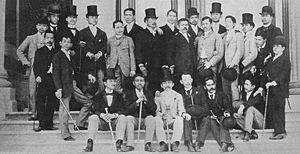Ilustrado facts for kids

The Ilustrados (pronounced ee-loos-TRAH-dos) were a group of smart and educated Filipinos in the late 1800s. This was during the time when Spain ruled the Philippines. The word "Ilustrados" means "enlightened ones" or "learned ones."
These individuals were often from wealthy or middle-class Filipino families. Many of them went to school in Spain. There, they learned about new ideas like freedom and nationalism. They wanted to see big changes in how Spain governed the Philippines. They hoped for fairer rules and more power for Filipinos.
The Ilustrados played a very important part in starting Filipino nationalism. This is the feeling of pride and unity among Filipinos. They believed in a better future for their homeland.
The Rise of the Ilustrados
Many famous Filipino heroes were Ilustrados. Some of the most well-known were José Rizal, Marcelo H. del Pilar, Mariano Ponce, Antonio Luna, and Graciano López Jaena. They used their education to speak up for their people.
Speaking Out for Change
José Rizal wrote two famous novels, Noli Me Tangere and El Filibusterismo. These books showed the world the unfair things happening to Filipinos under Spanish rule. They helped many people understand the problems.
At first, the Ilustrados did not want the Philippines to be fully independent from Spain. Instead, they wanted equal rights for all Filipinos. They asked for the Philippines to be treated like a province of Spain. They also wanted Filipino priests to have more power in churches.
A Turning Point in History
A big change happened in 1872. Three Filipino priests, José Burgos, Mariano Gomez, and Jacinto Zamora, were executed by the Spanish. They were wrongly accused of leading a rebellion. This event made many Filipinos feel stronger about their nation.
After this and other harsh actions, the desire for independence grew. José Rizal himself was executed by the Spanish on December 30, 1896. His death made the Ilustrados and other groups, like Andrés Bonifacio's Katipunan, unite even more. The Katipunan was a secret society that wanted full independence.
Later, when the United States took over the Philippines, the Ilustrados continued to be important. Many of them were given government jobs. This helped them keep their strong position in Filipino society.
See also
- Spanish Filipino
- Filipino Mestizos
- Mestizos de Sangley (Chinese Mestizos)
- Assimilados
- Ladino people
- Black Ladino
- Évolués
- Affranchis
- Emancipados
- Filipino nationalism
- Spanish language in the Philippines
- Philippine literature in Spanish
- Principalía
- Gente de razón


